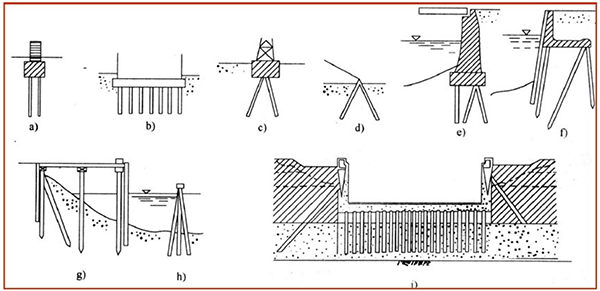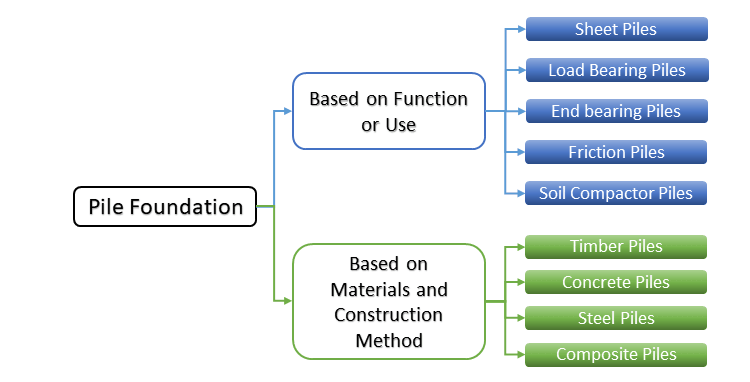What is Pile Foundation? Common Types, Material, Application of Pile Foundation.
Time:2024-01-31From:sinorock View:
Introduction
A Pile foundation is a long-standing and efficient foundation form that features high bearing capacity, broad application range, and a long historical lineage. As production levels and technological advancements continue to improve, the variety of pile foundations, process mechanisms, design theories, calculation methods, and application scopes have been significantly expanded, contributing to the construction of high-rise buildings, ports, bridges, and other projects. Pile foundations have played a key role in enhancing the efficiency of housing construction and establishing a robust foundation for the quality of modern construction.
.png)
What is Pile Foundation?
Generally, foundations can be broadly categorized as shallow and deep foundations. Shallow footings are typically used when the bearing capacity of the surface soil is sufficient to support the weight of a structure. On the other hand, deep foundations, which include various types, are typically used when the bearing capacity of the surface soil is not sufficient to support the weight of a structure. In such situations, the weight must be transferred to a deeper level, where the soil layer has a higher bearing capacity.
Pile foundation is one of the deep foundation types. It can be defined as a slender column or long cylinder made of concrete or steel used to support the structure and transfer the weight to the desired depth by end bearing or skin friction. Pile foundations are formed by long, slender, columnar elements typically made from steel or reinforced concrete, or sometimes timber. A foundation is considered "piled" when its depth is more than three times its breadth. Pile foundations are typically used for large structures and in situations where the soil at shallow depth is not suitable to resist excessive settlement, resist uplift, etc.
Common Applications of Pile Foundation
The versatility of pile foundations makes them suitable for an array of applications:
1. High and Heavy Buildings: Ideal for structures with demanding loads and deformation requirements.
2. Settlement Control: Used when natural foundation-bearing capacity meets requirements, but settlement needs reduction.
3. Heavy Industrial Plants: Perfect for buildings with substantial loads like warehouses and silos.
4. Precision Instrument Manufacturing: Offers stability for buildings with stringent stability requirements, minimizing ground vibrations.
5. Permanent Buildings on Soft Foundations: Ideal for structures on soft or weak foundations.

6. Un-uniform Loads: Suited for structures with heavy and uneven loads from the superstructure.
7. Cost and Feasibility: Deployed when other foundation types are costlier or impractical.
8. Compressible Soil: Utilized when the soil at shallow depth is compressible.
9. Scouring Possibility: Employed near riverbeds or seashores to prevent scouring.
10. Proximity to Canals or Drainage Systems: Applied when structures are near water bodies.
11. Poor Soil Conditions: When soil excavation is challenging due to unfavorable conditions.
12. Water Seepage Challenges: Implemented when keeping foundation trenches dry is impractical due to heavy seepage.
Classifications of Piles
Pile foundations come in various types, classified based on function, materials, installation process, and diameter:
A. Based on Function or Use:
1. Sheet Piles
2. Load Bearing Piles
3. End Bearing Piles
4. Friction Piles
5. Soil Compactor Piles
B. Based on Materials and Construction Method:
1. Timber Piles
2. Concrete Piles
3. Steel Piles
4. Composite Piles
C. Classification by Pile Diameter:
1. Small Piles (d≤250 mm)
2. Medium Diameter Piles (250 mm<d<800 mm)
3. Large Diameter Piles (d≥800 mm)

Common Types of Piles
A. Friction Pile:
- Pressure Piles: Used in geological situations lacking a hard bearing layer.
- Tension Piles: Employed in areas with deep or absent bearing layers.
B. End Bearing Piles:
The foundation pile is placed on the bearing layer so that the pile cap can carry the superstructure.
According to the construction process, they can be divided into lei cement-soil piles, bored piles, and impact H-piles.
- Lei Cement-Soil Pile: Driven into the ground by a piling machine. The advantages are material saving, high strength, and suitability for more demanding buildings. The disadvantages are high construction difficulty, long construction time limited by the number of machines, and not suitable for land made by pond filling/reclamation.
- Bored Pile: Firstly, holes are drilled on the construction site, and when the required depth is reached, the reinforcement is put in and concrete is poured. The advantage is that the construction difficulty is low, especially for hand-dug piles, which can be free from the limitation of the number of machines and save time greatly. The disadvantage is that the bearing capacity is low and it costs materials.
- Impact H-Piles: Ideal for lands with shallow bedrock.
C. Other Types:
- Jet Grouting Piles (JGP): Jet grout piles (JGP) is a ground improvement method that is constructed beneath the final excavation level to prevent basal heave instability, control wall deflections and reduce the strut loads for braced excavations in deep deposits of soft clay. Jet Grouting is a technique of mixing in-situ soil with the energy of high-pressure jet of slurry. A small-diameter rod drills down to the improvement bottom. Then the rod, while being withdrawn, jets the cement-base slurry and air to produce an improved column. The compressed air and hardening agents which usually consists of cement and water are jetted with a high-pressure energy and discharge rate from jet monitors in horizontal direction to construct larger diameter soil-cement columns.
- Micropile: Also called mini-piles, pin-piles, or root piles, is a high-performance and high-capacity deep foundation drilling materials. Micropile is a type of grouted pile that uses a drilling and pressure grouting construction process.
- Sheet Pile: Also known as steel sheet pile or sheet piling. The advantages of sheet piles are: high strength, easy to penetrate into the hard soil layer; can be constructed in deep water, and become a cofferdam with inclined support if necessary. Good waterproof performance; can form various shapes of cofferdam as needed and can be reused many times
- Soldier Piles: Also known as Berlin walls or king piles. Generally used for foundation pit support, slope support and landslide management, bearing horizontal earth pressure or landslide thrust, generally need higher reinforcement than foundation piles bearing vertical force.
Materials of Piles
1. Timber Piles
2. Steel Piles, Pipe Piles
3. Prestressed Concrete Piles
4. Composite Piles: A blend of steel and concrete members forming a single pile.
Designing the Foundation Pipes
1. Choosing the Right Pile Foundation:
The reasonable choice of pile foundation form has a great influence on the safety, function, and cost of high-rise buildings. The choice of pile foundation form should consider the following aspects.
(1) Geological conditions.
(2) The physical and structural characteristics of the building.
(3) The way of using underground space for building functions.
2. Bearing Layer and Pile Length:
(1) Provide a large enough single pile bearing capacity.
(2) To ensure that the building does not produce an excessive settlement.
(3) Considering the cost of pile foundation
(4) Consider the possibility of pile construction technology.
3. Reasonable Pile Arrangement:
In the case of the same number of piles, the bearing capacity and the role played by the pile foundation are not the same under different ways of pile arrangement.
4. Horizontal Bearing Capacity:
The horizontal shear force and overturning moment of the base of high-rise buildings are mainly caused by earthquakes and wind. The horizontal shear force of the foundation caused by earthquakes generally does not exceed 5% of the total weight of the high-rise building. Because the center of gravity of the superstructure of the high-rise building is much higher than that of the foundation bottom, it also causes great overturning moments. These effects must be considered in the earthquake area. In coastal areas, due to the intrusion of ocean storms, the impact of wind may be even greater than that of earthquakes. For super high-rise buildings, the wind-induced horizontal shear and overturning moment of the base may be close to or even far exceed the results caused by the earthquake. Therefore, the pile foundation of a high-rise building must have enough ability to resist horizontal load and overturning moments.
5. Environmental Impact:
Balancing technical and economic rationality in construction and use.
Conclusion
In conclusion, pile foundations have transcended their historical roots to become integral components in modern construction. As technology advances and the industry evolves, the understanding and application of pile foundations will continue to shape the future of structural engineering. Whether supporting towering skyscrapers or fortifying intricate infrastructure, the deep roots of pile foundations continue to lay the groundwork for a stable and resilient built environment.
For over a decade, Sinorock has been a key player in geotechnical anchoring materials, contributing to foundation engineering and underground tunnel construction. For inquiries about geotechnical anchoring, feel free to contact Sinorock at sinorock@sinorockco.com for expert guidance.
latest news
-

- What Are the Applications of SDA Bolts in Hydropower Stations?
- Time:2025-08-21From:This Site
- Learn how self-drilling anchor bolts enhance slope stability, tunnel support, and dam reinforcement in complex geological conditions at hydropower stations. Optimize hydropower projects with efficient, cost-effective, and eco-friendly solutions.
- View details
-

- Slope Stabilization with SDA Bolts: Benefits & Applications
- Time:2025-08-19From:This Site
- Discover how self-drilling anchor bolts (SDA bolts) provide superior slope stabilization for highways, railways, and tunnels. Learn their key benefits, installation process, and real-world applications in loose or collapsible soils.
- View details
-

- How Self-Drilling Rock Bolts Enhance Tunnel Support in Fractured Rock?
- Time:2025-08-15From:This Site
- Discover how self-drilling rock bolts enhance tunnel support in fractured rock. Learn their benefits, installation steps, and real-world applications for safe, efficient tunneling.
- View details
-

- Sinorock 2025 Quality Month | Strengthening Quality Foundations, Empowering Product Excellence
- Time:2025-08-13From:This Site
- Sinorock’s 2025 Quality Month, themed “Strengthening Quality Foundations, Empowering Product Excellence,” successfully concluded, reinforcing our commitment to superior product quality.
- View details
-

- Sinorock Safety Month 2025 | Everyone Speaks Safety, Everyone Can Respond
- Time:2025-07-03From:This Site
- Sinorock Safety Month 2025, centered on the theme "Everyone Speaks Safety, Everyone Can Respond - Spot Workplace Hazards," has wrapped up successfully!
- View details
-

- Quality Control: the Vital Factor of A SDA Bolt Factory
- Time:2025-01-09From:This Site
- Sinorock’s comprehensive quality control system, from supplier management to outgoing inspections, ensuring the highest standards for self-drilling anchor bolts in construction.
- View details
-

- Sinorock Invites You to Explore Proven Self-Drilling Anchor Bolt Solutions at bauma 2025
- Time:2025-03-07From:This Site
- From April 7–13, 2025, explore Sinorock’s Self-drilling anchor bolt solution at Booth C2.513/4 in Hall C2 of the Messe München Exhibition Center (Munich, Germany).
- View details
-
.jpg)
- SINOROCK to Attend EXPOMINA PERÚ 2024 in Lima, Peru
- Time:2024-08-10From:This Site
- Sinorock to Attend EXPOMINA PERÚ 2024 in Lima, Peru
- View details
-
.jpg)
- SINOROCK to Participate in MINING AND METALS CENTRAL ASIA 2024
- Time:2024-08-08From:This Site
- SINOROCK to Participate in MINING AND METALS CENTRAL ASIA 2024
- View details
 Download
Download 


